In This Issue
- Director’s Message:
2022 State of Vitiligo - Support VSI
- VSI Awarded:
Guidestar Gold Seal of Transparency - Camp Discovery 2022!
- Why Did I Get Vitiligo?
No one else in my family has it. - FDA Vitiligo Meeting Update
- Medicare Coverage for
Vitiligo Treatments - What’s on Your Mind?
- Medical News Updates
- Research & Clinical Trials
- Bibliography and Sources
VSI Medical and Scientific
Advisory Committee
- Committee Chair:
Pearl E. Grimes, M.D. - Ted A. Grossbart, Ph.D.
- Sancy A. Leachman, M.D.
- I. Caroline Le Poole Ph.D.
- Mauro Picardo, M.D.
- Nanette B. Silverberg, M.D.
- Richard A. Spritz, M.D.
- Alain Taieb, M.D., Ph.D.
- Wiete Westerhof, MD, Ph.D.
Contact Us
Online: www.VitiligoSupport.org
Email: Contact Us
Postal Mail Address
Vitiligo Support International
P.O. Box 3565
Lynchburg Va 24503
Phone: (434) 326-5380
Message From the Executive Director
 Dear VSI Members, Friends, and Donors,
Dear VSI Members, Friends, and Donors,
As we step into a new year, I feel somewhat hopeful, as well as thankful, that we seem to be inching our way back toward the life we once knew. While many have suffered hardship and loss, as is so often the case during difficult times, the spirit of generosity has opened the hearts of many to offer support to those in need. That same spirit is leading us into a future shining bright with promise!
These are truly exciting times for vitiligo. Not only do we finally have the attention of the pharmaceutical industry, but we will make history this spring when, if all goes as planned, vitiligo will have its first ever FDA approved, on-label treatment for the repigmentation of vitiligo!
For decades, those seeking vitiligo treatments for repigmentation have had to settle for off-label medications approved for other conditions, such as eczema and psoriasis. This small detail has given insurance companies, as well as many physicians, a built-in excuse not to prescribe, or cover, desperately-needed treatments.
Denied - Off-label - No Proof of Efficacy – Experimental
NO MORE!
We’ve Spoken Loud and in Numbers.
We Made our Case:
- To the Federal government: By speaking with Congressional representatives
- To the Food and Drug Administration (FDA): By testifying in record numbers, during their first ever vitiligo drug development meeting
- To multiple pharmaceutical companies: By providing first-hand feedback of the devastation this disease has on those affected
Where does that leave us? We will not relent!
We’ve persevered far too long, to slow down now.
How Can You Help?
Support VSI:
As a 501(c)(3) nonprofit organization,
VSI is dependent on public funding to operate.
If it's important that VSI continues its efforts on your behalf to:
Advocate Nationally;
Ensure the voice of the vitiligo patient is heard and understood;
And to Continue Providing
The most current, relevant vitiligo information available,
Please consider a donation, large or small, to sustain this vital work.
Together We Can Make a Difference.
Sincerely,
![]()
Jackie Gardner
Executive Director
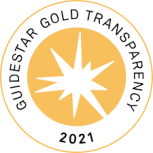
VSI is proud to announce that we have been awarded the
GuideStar Gold Seal of Transparency for 2021!
With a database of more than 1.8 million IRS-recognized organizations,
GuideStar is the most complete source of information about U.S. charities.
Camp Discovery 2022!

The American Academy of Dermatology’s (AAD) Camp Discovery program is for children ages 8-16 who have a chronic skin disease. Under the expert care of dermatologists and nurses, Camp Discovery gives campers the opportunity to spend a week with other young people with skin conditions having fun and participating in activities such as swimming, horseback riding, arts and crafts and many more. There is no fee to attend, all costs including transportation, are provided by the AAD through generous donations from its members, outside organizations and individuals.
- All children must be referred by their dermatologist. Parents can copy the Camper Referral form and take it to their dermatologist. Submission Deadline: April 8 or when space is full
- Volunteer Applicants must be at least 18 years of age and provide one letter of recommendation. Submission Deadline: April 2,2022 Click Here for Volunteer Information
- There is no fee to attend, all costs including transportation are provided by the AAD through generous donations from its members, outside organizations, and individuals.
2022 Camp Discovery Dates and Locations
Why Did I Get Vitiligo?
No One in my Family Has Ever Had It
VSI often hears questions from those recently diagnosed such as: “Why did I get vitiligo? “How can it be hereditary when no one else in my family has ever had it?” “Is it contagious?” One of the most emotional questions we receive, “Will my children get vitiligo?”
Unfortunately, it is not simple to answer the question of why one person in a family has vitiligo and others do not.
To begin with, NO, vitiligo is most definitely not contagious!
While the genetic or biological components play a role in a person’s susceptibility to vitiligo, research indicates that this genetic predisposition may factor as little as 30% toward disease development, with the environmental factors weighing in closer to 70%, as evidenced by identical twins. Even though they share identical DNA, both develop vitiligo only 23% of the time.
Genetic Predispositions
A genetic predisposition (genetic susceptibility) is an increased likelihood of developing a particular disease based on a person’s genetic makeup. A genetic predisposition results from specific genetic variations that are often inherited from a parent. These genetic changes contribute to the development of a disease but do not directly cause it. Some people with a predisposing genetic variation will never get the disease while others will, even within the same family.
Source: Bartee L. Multifactorial Disorders and Genetic Predispositions.
Principles of Biology: Biology 211, 212, and 213. Open Oregon Press Books.
While 1 out of 5 vitiligo patients have a family member with the same condition,
only 5% to 7% of children will get vitiligo even if a parent has it.
Meaning: There is a 93% to 95% Chance that
Children of a Parent with Vitiligo Will NOT Develop Vitiligo.
This indicates that the non-genetic (environmental) components also play a significant role in the triggering of the onset, or worsening of vitiligo. This is why it’s possible for only one person in a family to develop the disease. It doesn’t mean that another family member may not develop vitiligo at a later time, or that there are no genetic links to vitiligo in your family.
For example, one identical twin may have experienced a great deal of emotional stress, such as the death of a close friend, and developed vitiligo at age 22. Without that stress, the other twin could develop vitiligo later in life or never.
Vitiligo, by definition, is a complex, multifactorial, polygenic disease.

- Complex and multifactorial diseases are caused by the inheritance of multiple genes and a combination of genetic, environmental, and lifestyle factors. They do not have a clear-cut pattern of inheritance, and often cluster in families.
- Polygenic diseases are genetic (inherited) diseases caused by the effects of the simultaneous action or interaction of multiple genes, but are not influenced by environmental factors.
What Does That Mean?
As noted above, there are many factors involved with developing vitiligo, beginning with the different combinations of genes each person inherits from their parents.
Consider the ways some family members look more like one than another. One might be tall with blue eyes and another short with brown eyes. Your family’s genes are carried not only among your immediate family, but also your extended family, which includes your grandparents, aunts, uncles, and cousins.
In my family for instance, some people say I look more like my maternal aunt than my mother. Most likely that’s because my aunt and I both share some of the same genes from my mom’s side of the family.

Think of the genes in your DNA as candy sprinkles. Each color carries susceptibility to a different trait or disease. Your mother might carry the genes for green eyes, short in stature, type 1 diabetes, and psoriasis, while your dad might carry genes for brown eyes, tall in height, vitiligo, and irritable bowel syndrome.
Each child inherits different sets of genes from each parent. One might inherit blue-eyed genes and another brown. One might inherit a small number of vitiligo susceptibility genes, while another inherits a wide array of them. Kind of like the ice cream cones below: some have a large concentration of various colors of sprinkles, while others have less or very few, and each has different combinations.

But - What are Environmental Factors?
Some Lifestyle Factors Found to Negatively
Influence and/or Trigger Autoimmunity:
Obesity
Smoking
Exposure to chemical toxins
Exposure to certain infections:
- Epstein Barr Virus
- SARS-CoV-2 Virus is associated with autoimmune disease in various ways, although researchers are still investigating the relationship. COVID-19 infection has been reported to trigger cases of Guillain-Barre syndrome, antiphospholipid syndrome, lupus, and other diseases.
Chemical-Induced Vitiligo
A variety of industrial chemicals, as well as household and cosmetic products, have been identified as triggering “chemical-induced vitiligo.” Some of the most well-known are the phenol-based derivatives found in hair dyes, which have been shown to cause pigment loss not only at the site of exposure (where applied) but, over time, may result in progressive, generalized vitiligo, with pigment loss spreading to remote areas of the body that had no chemical exposure.
The product label below is from a men’s black hair dye,
and includes the following warning citing vitiligo as a possible side effect.

You may recall VSI’s previous newsletter report about Kanebo, a cosmetic company in Japan that sold skin-lightening products containing the active ingredient rhododenol [4-(4-hydroxyphenyl)-2-butanol] that resulted in nearly 20,000 consumers developing vitiligo-like depigmentation. The company initiated a voluntary recall of 54 skin whitening products affecting nearly 5 million sales in 11 Asian countries. You can read more about that in VSI's Summer 2018 Newsletter.
A variety of products, from cosmetics, adhesives, and household disinfectants, to occupational and commercial chemicals, have been specifically identified as potentially problematic to those with vitiligo.
Koebner-Induced Pigment Loss
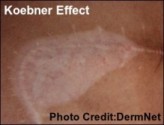 Another vitiligo trigger, known as the Koebner effect, is pigment loss occurring at the site of an injury or skin trauma, such as cuts, scratches, burns, or friction, such as the waistband where clothing rubs.
Another vitiligo trigger, known as the Koebner effect, is pigment loss occurring at the site of an injury or skin trauma, such as cuts, scratches, burns, or friction, such as the waistband where clothing rubs.
Recognizing Stress
As mentioned, emotional stress has long been recognized as a trigger for many autoimmune diseases, including vitiligo. However, many people become so accustomed to the rigors of their daily lives that they don’t recognize the stress they are experiencing.
Stress is commonly defined as physical, psychological, or emotional experiences that cause tension. Chronic, or persistent, stress, such as job-related problems, financial difficulties, or unhealthy interpersonal relationships can lead to chronic health problems such as heart disease, high blood pressure, or A/I diseases.
 One of the first steps in controlling the stress in your life is recognizing your stressors. In doing so, it’s important to note that stress perception is unique to each individual. Something that causes stress for one person may not be a problem for another.
One of the first steps in controlling the stress in your life is recognizing your stressors. In doing so, it’s important to note that stress perception is unique to each individual. Something that causes stress for one person may not be a problem for another.
One example would be public speaking. Some people enjoy the limelight and look forward to giving presentations, while the exact same situation for others can cause dread, anxiety, and even loss of sleep for weeks or months in advance.
It’s also important to note that not all stress comes from negative experiences. There are times that positive/happy events can bring major stress into your life. Examples might include planning a wedding, getting married, moving into a new home, or enduring home renovations.
Stress and Vitiligo

Research has found psychological/emotional stress to be debilitating to the immune system, leaving it more vulnerable to disease, infection, and underlying conditions such as vitiligo. A 2012 French study found that out of 213 patients in the study, stress contributed to the onset of vitiligo in 31% of those with non-segmental vitiligo.
Dr. Caroline LePoole and researchers from Loyola University in Chicago, IL have delved deeply into the scientific causes and pathways tying emotional stress to the onset or worsening of vitiligo. Their research was responsible for the discovery of the inducible heat shock protein 70 (HSP70i), released by cells like melanocytes (pigment making cells) when under stress. These cells are known to play a pivotal role in the development of vitiligo. Read more about this in VSI’s Fall 2018 Newsletter.
Several years ago VSI conducted a (non-scientific) poll.
We asked the 2 following questions:
- Did you experience a particularly stressful event in the months prior to developing or the spreading of your vitiligo?
- How long before the pigment loss did the stress occur?
The Family Connection?
While there are many pieces involved in the puzzle of who or when a person will develop vitiligo, there are clues to look for that may help pinpoint other family members that might be carrying susceptibility genes.
A good place to begin is by identifying the type of vitiligo you have, which is important because the different types of vitiligo are associated with the potential of different underlying conditions.
Many times, it is the underlying conditions that not only help identify other family members who may share common risk genes, but also provide a bigger picture of just how many risk factors may have been involved with the eventual tipping point leading to the development of vitiligo.
There are three primary types of Vitiligo:
Non-Segmental Vitiligo (NSV)
Segmental Vitiligo (SV)
Mixed Vitiligo (MV)
Non-Segmental Vitiligo (NSV), also known as generalized vitiligo, is the most common type. One of the most significant and distinguishing characteristics of NSV is its autoimmune association.
Because the development of most A/I diseases includes a hereditary component, the A/I connection is a key piece of the genetic puzzle linking vitiligo to other family members.
Autoimmune diseases are sort of like a family tree in the way that some A/I diseases interrelate with others by sharing some of the same genes. This connection helps explain why some AI diseases occur together more frequently in what researchers and physicians refer to as a cluster.
Some of the other A/I diseases in vitiligo’s cluster, more commonly found among those with vitiligo as well as their extended family members, include autoimmune thyroid disease (AITD), type 1 diabetes, inflammatory bowel disease (IBD), rheumatoid arthritis (RA), and pernicious anemia.
In the diagram below, the cross-over, or intersection that you see, illustrates the underlying risk genes that the different A/I diseases share, or have in common.
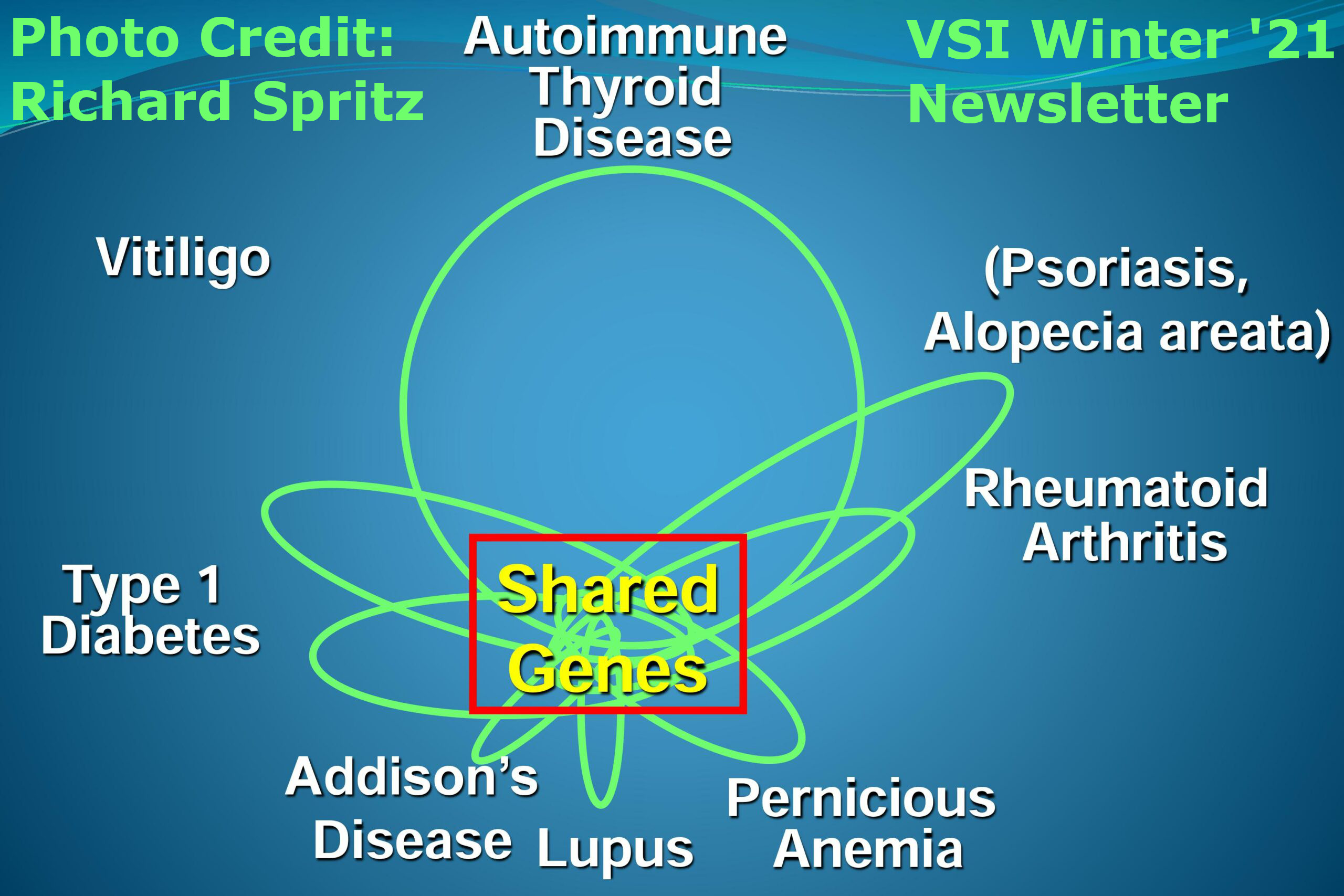
In addition to autoimmunity, other NSV characteristics include:
 Both sides of the body are involved,
Both sides of the body are involved,
with pigment loss often in a mirror-type manner.
Emotional stress (exams, job loss, death in family, divorce etc.)
often precedes onset or flares.
Itching (pruritus), ranging from mild to intense, may occur at the involved site prior to noticeable pigment loss, resolving after the depigmentation.
The itching is theorized as an inflammatory autoimmune response, occurring in those affected during active phases of vitiligo. Some people describe other sensations such as warmth, burning, or stinging, as well as tingling, and crawling in these same locations. Many of those who experience this type of symptom report it to be significant enough to impact their daily life, as well as causing sleep disturbance.
 From a diagnostic point of view, these sensations can be helpful in identifying active vitiligo before pigment loss is visible, enabling early treatment. However, this can also be a double-edged sword. The subsequent scratching of the skin can induce a Koebner response, further exacerbating the situation. It’s wise to consult your physician as soon as possible and begin treatment to both to ease the itching and to catch pigment loss before it spreads. Many people report that the topical corticosteroids prescribed for vitiligo help with this.
From a diagnostic point of view, these sensations can be helpful in identifying active vitiligo before pigment loss is visible, enabling early treatment. However, this can also be a double-edged sword. The subsequent scratching of the skin can induce a Koebner response, further exacerbating the situation. It’s wise to consult your physician as soon as possible and begin treatment to both to ease the itching and to catch pigment loss before it spreads. Many people report that the topical corticosteroids prescribed for vitiligo help with this.
 Premature graying of hair, defined as more than 50% white hair on the head before the age of 40, is more often noted in the family history (immediate and extended family members) of those with NSV. Scientists hypothesize that those with premature gray hair share common A/I-predisposing genes with vitiligo.
Premature graying of hair, defined as more than 50% white hair on the head before the age of 40, is more often noted in the family history (immediate and extended family members) of those with NSV. Scientists hypothesize that those with premature gray hair share common A/I-predisposing genes with vitiligo.
 Multiple halo nevi (moles surrounded by a white ring or halo) are another characteristic associated with autoimmunity, and are almost always non-cancerous.
Multiple halo nevi (moles surrounded by a white ring or halo) are another characteristic associated with autoimmunity, and are almost always non-cancerous.
Segmental Vitiligo (SV), most often begins at an early age (12 years and under), and is not typically associated with autoimmunity.
In contrast with NSV, segmental usually affects a confined area on one side of the body, such as one side of the mouth or neck.
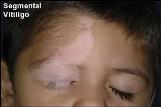 Other characteristics of SV include that it generally spreads fairly quickly at onset, then slows and remains stable after a year or so.
Other characteristics of SV include that it generally spreads fairly quickly at onset, then slows and remains stable after a year or so.
More than half of those affected by SV will also have patches of white hair on the affected areas, as seen here on the eyelashes.
Mixed Vitiligo (MV) is defined as when a person first develops segmental vitiligo that later progresses into nonsegmental vitiligo, becoming “Mixed.”
The diagram below from the 2012 French study shows the rate of occurrence of the characteristics experienced by NSV and SV patients in their study. You'll see that symptoms such as pruritus (itching) and halo nevi occur in significant numbers among the NSV patients, but in negligible percentages of the SV group. The areas of overlap are flags for potential of later progression to MV.
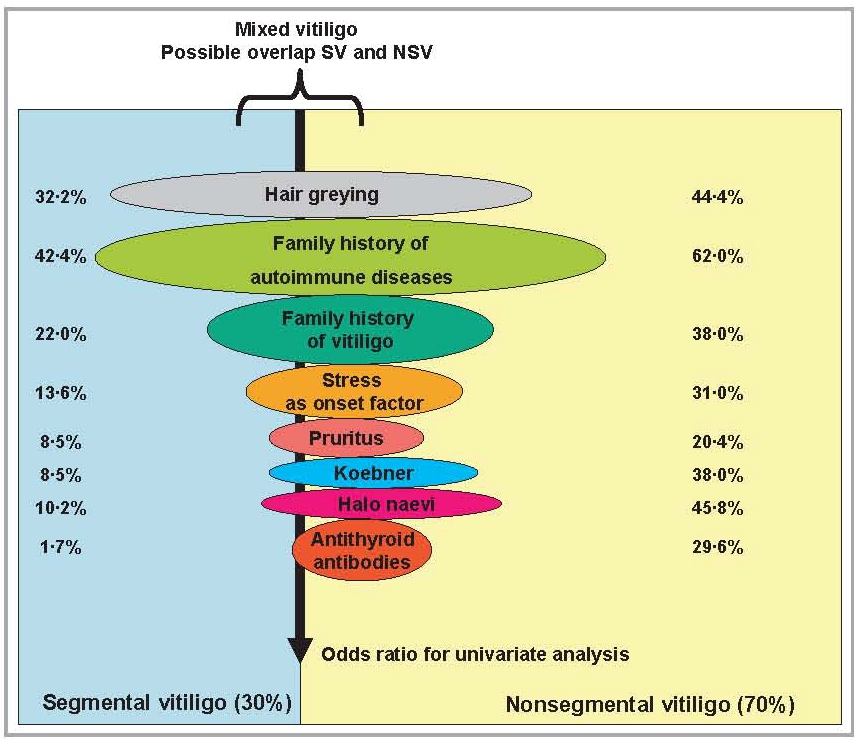
Vitiligo Family Connection – Unraveling the Mystery
Going back to the question of how vitiligo can be hereditary when no one else in a family has ever had it - as mentioned above, the autoimmune connection likely provides the greatest number of clues.
If anyone in your immediate or extended family has experienced premature graying of hair, halo nevi, or has been diagnosed with any of the A/I diseases in the vitiligo cluster, especially autoimmune thyroid disease, chances are that they, too, share some of the same genes in the vitiligo pool.
Who Will Get Vitiligo?

While genetic research in recent years has made tremendous discoveries, there are times when it seems the more we learn, the more we realize how much we still don’t know.
Researchers hypothesize that the more risk factors there are involved, the more likely a person is to develop an autoimmune disease. Envision a healthy immune system like a balanced see-saw. Everyone has setbacks from time-to-time that upset the balance. However, it’s unlikely that a single gene or experience would trigger the onset of an A/I disease. It’s more likely to be a long-term cascade of events and stresses. The more risk factors you add, the closer you come to tipping the balance toward disease development.
Knowing your family history can help identify potential health risks in your family genes, giving you a chance to proactively reduce risks with early testing and diagnosis. Combining this knowledge with a healthy lifestyle is your best defense against disease development.
FDA-Vitiligo Meeting Update

Many of you will remember one of the greatest vitiligo events of 2021,
the Food and Drug Administration’s (FDA’s) Patient-Focused
Drug Development Meeting for Vitiligo.
We can all be proud of the record number of registrants and attendees!
There were two sessions, each with panelist discussion,
as well as comments from call-in participants.
Session 1: The Health Effects and Daily Impact of Vitiligo
Session 2: Patient Perspectives on Current Approaches to Treatment
The FDA recently released the following meeting summary:
Voice of the Patient Report - Vitiligo
For anyone who missed the meeting, if you would like to watch the meeting recording,
you’ll find that and additional information in VSI’s Spring 2021 Newsletter
Calling all Medicare Vitiligo Patients!
 VSI regularly hears from patients from all over the United States who have been denied insurance coverage for their vitiligo treatment. VSI has been fighting this battle on a national level for several years. While we are definitely making progress, it’s been a slow road.
VSI regularly hears from patients from all over the United States who have been denied insurance coverage for their vitiligo treatment. VSI has been fighting this battle on a national level for several years. While we are definitely making progress, it’s been a slow road.
Part of the problem is that currently there is no accepted standard for coverage of vitiligo treatments. Each company has their own policies and guidelines, many times based on outdated and incorrect information.
What most people may not realize is just how much private insurance coverage can be affected by Medicare policies. Over 55 million Americans are now covered by Medicare or Medicare Advantage, making it the nation’s largest health insurance program Consequently, many, if not most, insurance providers establish their baseline standards and procedures to follow the Medicare model.
Medicare has agreed to meet with us – but requires that we bring Medicare letters of denial for a vitiligo treatment.
coverage for a vitiligo treatment by Medicare, please contact VSI immediately.Click Here to Contact VSI

What's On Your Mind?
Q. Should I get a flu shot?
I’m 65 years old and have vitiligo. I’m concerned because I’ve heard that if you have a weakened immune system you should not get a flu shot, but my mother died of flu complications last year. I’m afraid if I don’t get the flu shot, I could become very sick, or even worse, die like my mother.
Does having an autoimmune disease like vitiligo
mean that I have a weakened immune system?
I don’t know what to do.
- There are two misconceptions with the idea that having an autoimmune disease means you have a weakened immune system and shouldn’t get a flu shot.
- Having an autoimmune disease doesn’t necessarily
mean that you have a weakened immune system.
- Having a weakened immune system does
not mean you should not get a flu shot!
Autoimmune vs. Immune Deficient
 Immune deficiency (or immunodeficiency disorders) reduces the ability of your body’s immune system to defend itself from foreign cells such as bacteria, viruses, parasites, or disease, such as cancer. An example of an immunodeficiency disorder would be HIV (human immunodeficiency virus), which can lead to the disease AIDS (acquired immunodeficiency syndrome).
Immune deficiency (or immunodeficiency disorders) reduces the ability of your body’s immune system to defend itself from foreign cells such as bacteria, viruses, parasites, or disease, such as cancer. An example of an immunodeficiency disorder would be HIV (human immunodeficiency virus), which can lead to the disease AIDS (acquired immunodeficiency syndrome).
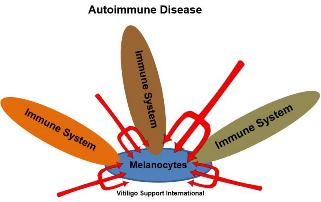 Autoimmune diseases are the result of the other side of immune dysfunction, whereby the immune system becomes overactive or hyper-responsive to very specific cells that are naturally present within its own body. In the case of vitiligo, your body’s immune system is attacking your melanocytes, which are your pigment-making cells.
Autoimmune diseases are the result of the other side of immune dysfunction, whereby the immune system becomes overactive or hyper-responsive to very specific cells that are naturally present within its own body. In the case of vitiligo, your body’s immune system is attacking your melanocytes, which are your pigment-making cells.
Now let’s address the misconception that those
with a weakened immune system should not get a flu shot.
The opposite is actually the case. Those who DO have a weakened immune system are among those considered to be at highest risk of developing serious flu-related complications and should take all preventive measures to avoid contracting the flu, including receiving the flu vaccine.
Who Should Get a Flu Shot?
According to the Centers for Disease Control (CDC), all age groups are susceptible to influenza and “everyone 6 months and older is recommended for annual flu vaccination with rare exception.” Those listed below are considered among the highest risk of developing serious flu-related complications.
Children younger than 5, but especially children younger than 2 years old
Adults 65 years of age and older
Pregnant women (and women up to two weeks postpartum)
Those with medical conditions such as:
Asthma
Weakened immune system due to disease or medication (such as people with HIV or AIDS, or cancer, or those on chronic steroids or chemotherapy)
Endocrine disorders, including the following often associated with vitiligo: Hypo- and Hyper- Thyroid Disease, Hashimoto’s Thyroiditis, Graves’ Disease, Type 1 Diabetes, Addison’s Disease, Adrenal Disorders, and Metabolic Syndrome.
Click here for a complete list of those considered at high risk.
Click here for a complete list of endocrine disorders.
The Two Primary Types of Flu Vaccine:
Flu Shot and Nasal Spray
Who should NOT Get a Flu Shot?
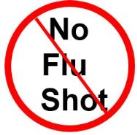
- Children under the age of 6 months
- People who are sick or not feeling well
- Anyone who has ever had Guillain-Barré Syndrome (also called GBS) should talk with their doctor prior to getting a flu shot
- Anyone with severe allergies to the flu vaccine, or any of the vaccine ingredients, such as gelatins, antibiotics, or eggs.
Because vaccines are developed by being injected into chicken eggs to incubate, if you have an allergy to eggs, you should discuss the options with your physician. There is an alternative formula called Flublok that does not use the influenza virus or chicken eggs in its manufacturing process.
 The nasal spray, also referred to as the live attenuated influenza vaccine (LAIV), contains a live form of the flu virus that has been modified/weakened so that it cannot cause the flu virus. This is sold under the trade name FluMist in the United States and Canada, and Fluenz in Europe.
The nasal spray, also referred to as the live attenuated influenza vaccine (LAIV), contains a live form of the flu virus that has been modified/weakened so that it cannot cause the flu virus. This is sold under the trade name FluMist in the United States and Canada, and Fluenz in Europe.
Due to a significant decline in the effectiveness, particularly the H1N1 component, the CDC removed the Flumist from its list of recommended vaccines for the past 2 flu seasons. However, in February 2018, by a 12-to-2 margin, the CDC vaccine panel voted to restore its status to the approved list.
Who Should NOT Get the Live Attenuated Nasal Vaccine?
According to the CDC: “Some people should not get LAIV because of age, health conditions, or other reasons. Most of these people should get an injected flu vaccine instead. Your healthcare provider can help you decide.”
Tell the Provider if you or the Person Being Vaccinated:
- have any allergies, including an allergy to eggs, or have ever had an allergic reaction to an influenza vaccine
- have ever had Guillain-Barré Syndrome
- have any long-term heart, breathing, kidney, liver, or nervous system problems
- have asthma or breathing problems, or are a child who has had wheezing episodes
- are pregnant
- are a child or adolescent who is receiving aspirin or aspirin-containing products
- have a weakened immune system
- will be visiting or taking care of someone, within the next 7 days, who requires a protected environment (for example, following a bone marrow transplant)
Because you noted that you are age 65, which puts you in the high risk group, there is another option you could consider. There is an alternative vaccine specifically for individuals 65 years and older that goes by the name Fluzone High-Dose (also Fluzone Intradermal Quadrivalent, and Fluzone Quadrivalent).

According to the CDC: “People 65 years and older bear the greatest burden of severe flu disease. In recent years, for example, it’s estimated that between 71 percent and 85 percent of seasonal flu-related deaths, and between 54 percent and 70 percent of seasonal flu-related hospitalizations, have occurred among people 65 and older.”
Because human immune defenses weaken with age, and aging decreases the body’s immune response, this high dose vaccine was developed to create a stronger immune response. It has four times the amount of antigen (the part of the vaccine that prompts the body to make antibodies) contained in regular flu shots.
The bottom line is that the decision as to whether or not you should get a flu shot is one best made between you and your health care provider.
For additional information, see VSI’s Newsletter Article: Vitiligo and Vaccines
Medical Disclaimer
The above information is provided for informational purposes and not intended as medical advice. Each person’s health is unique to their own set of circumstances. All medical decisions should be discussed with your health care provider.
Medical News Updates
Highlights of recently-published medical
articles on vitiligo and its treatments
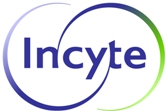
Ruxolitinib Cream for Vitiligo!
Targeted to Receive FDA Approval on April 18, 2021!
VSI has been reporting on this exciting news for over a year, following the approval updates of the same drug for use with mild to moderate atopic dermatitis (AD), and hoping approval for use with vitiligo would soon follow.
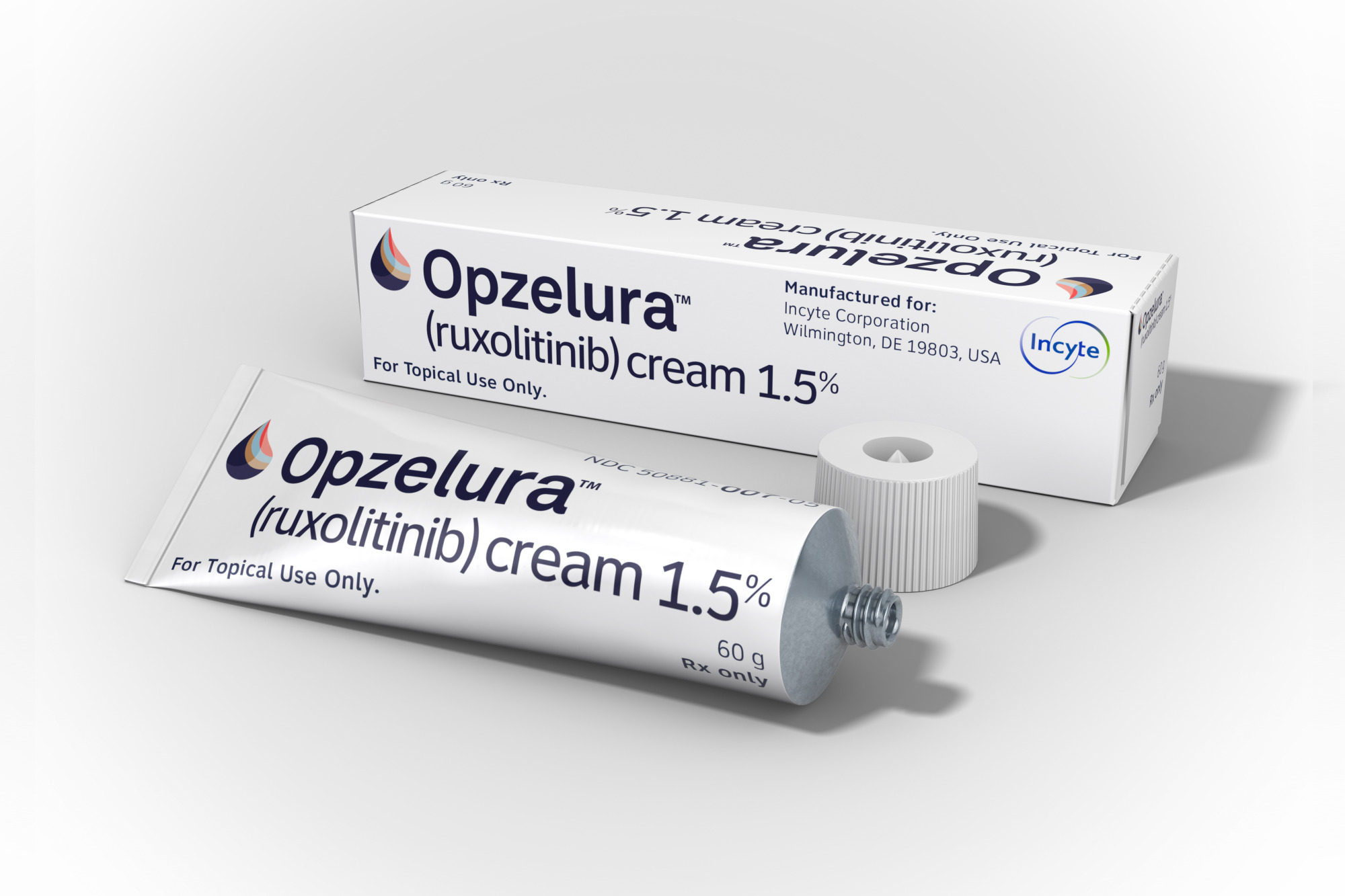
On December 14, 2021, Incyte announced that the topical JAK inhibitor, ruxolitinib cream 1.5% (Opzelura™) has received acceptance from the U.S. Food and Drug Administration (FDA) for Priority Review as a potential vitiligo treatment for adolescents and adults age 12 years and older.
The FDA grants Priority Review to medicines that may offer a major advance in treatment where none currently exists. Once the FDA accepts a filing for the approval of a drug, in most cases, the review process must be completed within 6 to 10 months.
The date at the end of the review period (referred to as the Prescription Drug User Fee Act (PDUFA) date) is the date by which the FDA expects to issue the action (approval) letter, and was developed in 1992 to improve access to medications for patients.
The PDUFA target action date for this first ever, FDA-approved, “on label” prescription for repigmentation of vitiligo, is set for April 18, 2022.
VSI will continue to provide updates on this promising information.
For additional information:
A Case Report of Vitiligo
Induced by Alexandrite Hair Removal Laser
Dr. Azzam Alkhalifah, from Qassim University in Saudi Arabia, recently submitted a case report regarding a 28-year-old female patient who was experiencing pigment loss on her legs and forearms as a result of a laser hair removal (LHR) procedure she had 4 weeks earlier.
There are several types of lasers used for LHR. The one used in this instance, the 755 nm alexandrite laser (AL) is among the most popular, known for its efficiency in covering large treatment areas in a short amount of time. It is considered most effective on lighter skin tones and thinner hair.
The downside of the AL is that the fast laser repetition is more painful than other systems, and can cause discoloration if used on darker skin tones.
Though neither the patient nor anyone in her family had ever had vitiligo, the patient had experienced a similar reaction 4 years earlier after undergoing full body LHR. At that time, the areas of pigment loss appeared all over her body. This time, the patches appeared only on her arms and legs in the areas that were treated.
Four years prior, the patient regained her pigment after 9 months of NB-UVB phototherapy. Dr. Alkhalifah began treatment on the affected areas using topical tacrolimus 0.1% and twice weekly NB-UVB phototherapy.
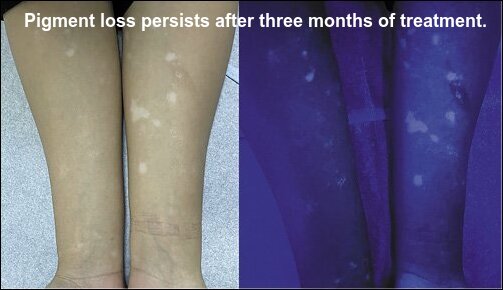
After three months of treatment, he noted only a small amount of repigmentation on the outer edges of the patches, which he felt indicated a total loss of melanocytes inside the patches.
Because the patient was unwilling to undergo a biopsy, he was unsure if this was an autoimmune reaction, or laser-induced vitiligo. Either way, he felt that vitiligo patients should be made aware of the possibility of pigment loss when using the alexandrite laser for hair removal.
Research and Clinical Trials
Multi-Center Vitiligo Treatment Clinical Trial
Irvine CA, Sacramento CA, New Haven CT
Phase 2 Clinical Trial Evaluating
AMG 714 Treatment for Vitiligo
New Study Locations!
UC Davis Dept. of Dermatology
3301 C. Street
Sacramento, California, 95816
Yale University School of Medicine
2 Church St. South
New Haven Connecticut, 06519
UCI Health Beckman Laser Institute
And Medical Center, Suite 222
Irvine, California, 92697
As VSI has previously reported, many times when a person experiences a vitiligo relapse, they lose pigment in the exact same location as a previous lesion, due to the discovery of autoimmune memory T cells. This new therapy targets and blocks the memory signaling and also removes these memory T cells, which is showing long-term improvement from short-term therapy.
Participants will be randomized into one of two groups
for a 24 week, double blind period.
Each group will receive 300 mg of AMG 714, or, placebo for AMG 714,
subcutaneously on Day 0 and every 2 weeks thereafter through week 10
(for a total of 6 doses).
At week 24, all participants who have not shown at least 25% improvement,
will begin NB-UVB phototherapy 3 times per week for a total of 24 weeks.
Key Inclusion Criteria:
- Clinical diagnosis of active or stable non-segmental vitiligo
- At least 0.25% facial depigmentation
- At least 3% depigmentation on the body
- Must be willing to undergo narrow band ultraviolet B (nbUVB) phototherapy
- Must discontinue all vitiligo treatments from screening through the final safety follow-up visit at week 48
Key Exclusion Criteria:
- More than 33% pigment loss on the face or on the total body
- Previous or current diagnosis of other cancer
- May never have used any depigmentation treatments
To participate, or for more information:
Irvine Contact:
Laura Ortiz - ph: 949-824-6483 - email: [email protected]
New Haven Contact:
Andrea DeClement - ph: 203-785-5182 - email: [email protected]
Sacramento Contact:
Angela Calaguas - ph: 916-734-1509 - email: [email protected]
Earn Funding for VSI with Amazon and eBay
Online Shopping Can Benefit VSI!
With thousands of items in addition to books, Amazon.com is a one stop-shopping center! Simply shop through the above link (bookmark it for easy reference) and VSI will earn fees, based on a percentage of the sale. The more items purchased by members, the higher the percentage!
Tobi Cares Donation Program
Tobi is an online women's clothing design label that brings LA style from its design studio direct to its online clothing store at tobi.com. Go to Tobi Cares and sign up for VSI to receive 1% of your purchase amount.
iGIVE SHOPPING
iGive.com offers access to free shipping deals and exclusive coupons, on top of the great deals you'll find every day through its network of 1,000+ stores, including Pottery Barn, REI, Staples, Petco, Expedia, Best Buy, QVC and many more. Best of all, up to 26% of your purchase at each store is donated to VSI at no cost to you! Let friends and family know so they can support VSI, too. Click register for iGive to get started today, and download the iGive button to automatically benefit VSI whenever you go to an included store.
GOODSEARCH SHOPPING AND DINING!
GoodSearch and Goodshop, like iGive, offers coupons, discounts, and donations to VSI through its network of over 5,000 stores. Just click the link above to get the savings started and the donations flowing!
*Vitiligo Support International Inc. (VSI) is a participant in the Amazon Services LLC Associates Program, an affiliate advertising program designed to provide a means for sites to earn advertising fees by advertising and linking to Amazon.com.
Earn Funding for VSI with eBay
Support VSI with eBay!
Do you sell items on eBay, or want to hold an online garage sale? If so, consider donating a percentage of your proceeds to VSI through eBay’s Giving Works program! It’s easy – when you list an item through a Giving Works listing, choose to send 10-100% of the final sale price to VSI. Your listing will have a special placement and designation. You’ll receive a proportional fee credit from eBay, and will also receive a tax donation receipt when the donation is deducted from your funds received. It’s a great opportunity to make some money for yourself and for VSI, so clean out those closets and garages and get selling!
A Vitiligo Support International, Inc. financial statement is available upon written request from the Virginia Office of Consumer Affairs. Mail requests to: Virginia Department of Agriculture and Consumer Services, Office of Consumer Affairs, P.O. Box 1163, Richmond, Virginia 23218.


